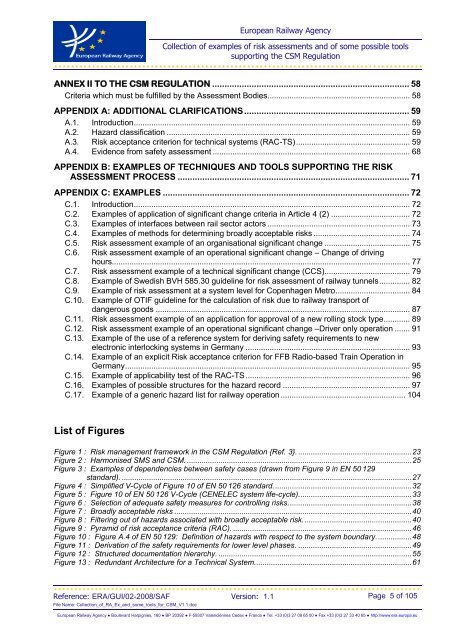Guidance for Use of CSM Recommendation - ERA - Europa
Guidance for Use of CSM Recommendation - ERA - Europa
Guidance for Use of CSM Recommendation - ERA - Europa
You also want an ePaper? Increase the reach of your titles
YUMPU automatically turns print PDFs into web optimized ePapers that Google loves.
European Railway Agency<br />
Collection <strong>of</strong> examples <strong>of</strong> risk assessments and <strong>of</strong> some possible tools<br />
supporting the <strong>CSM</strong> Regulation<br />
<br />
ANNEX II TO THE <strong>CSM</strong> REGULATION ................................................................................ 58<br />
Criteria which must be fulfilled by the Assessment Bodies ................................................................. 58<br />
APPENDIX A: ADDITIONAL CLARIFICATIONS ................................................................... 59<br />
A.1. Introduction .............................................................................................................................. 59<br />
A.2. Hazard classification ............................................................................................................... 59<br />
A.3. Risk acceptance criterion <strong>for</strong> technical systems (RAC-TS).................................................... 59<br />
A.4. Evidence from safety assessment .......................................................................................... 68<br />
APPENDIX B: EXAMPLES OF TECHNIQUES AND TOOLS SUPPORTING THE RISK<br />
ASSESSMENT PROCESS .............................................................................................. 71<br />
APPENDIX C: EXAMPLES .................................................................................................... 72<br />
C.1. Introduction .............................................................................................................................. 72<br />
C.2. Examples <strong>of</strong> application <strong>of</strong> significant change criteria in Article 4 (2) .................................... 72<br />
C.3. Examples <strong>of</strong> interfaces between rail sector actors ................................................................. 73<br />
C.4. Examples <strong>of</strong> methods <strong>for</strong> determining broadly acceptable risks ............................................ 74<br />
C.5. Risk assessment example <strong>of</strong> an organisational significant change ....................................... 75<br />
C.6.<br />
Risk assessment example <strong>of</strong> an operational significant change – Change <strong>of</strong> driving<br />
hours........................................................................................................................................ 77<br />
C.7. Risk assessment example <strong>of</strong> a technical significant change (CCS)....................................... 79<br />
C.8. Example <strong>of</strong> Swedish BVH 585.30 guideline <strong>for</strong> risk assessment <strong>of</strong> railway tunnels .............. 82<br />
C.9. Example <strong>of</strong> risk assessment at a system level <strong>for</strong> Copenhagen Metro .................................. 84<br />
C.10. Example <strong>of</strong> OTIF guideline <strong>for</strong> the calculation <strong>of</strong> risk due to railway transport <strong>of</strong><br />
dangerous goods .................................................................................................................... 87<br />
C.11. Risk assessment example <strong>of</strong> an application <strong>for</strong> approval <strong>of</strong> a new rolling stock type............ 89<br />
C.12. Risk assessment example <strong>of</strong> an operational significant change –Driver only operation ....... 91<br />
C.13. Example <strong>of</strong> the use <strong>of</strong> a reference system <strong>for</strong> deriving safety requirements to new<br />
electronic interlocking systems in Germany ........................................................................... 93<br />
C.14. Example <strong>of</strong> an explicit Risk acceptance criterion <strong>for</strong> FFB Radio-based Train Operation in<br />
Germany .................................................................................................................................. 95<br />
C.15. Example <strong>of</strong> applicability test <strong>of</strong> the RAC-TS ........................................................................... 96<br />
C.16. Examples <strong>of</strong> possible structures <strong>for</strong> the hazard record .......................................................... 97<br />
C.17. Example <strong>of</strong> a generic hazard list <strong>for</strong> railway operation ......................................................... 104<br />
List <strong>of</strong> Figures<br />
Figure 1 : Risk management framework in the <strong>CSM</strong> Regulation {Ref. 3}. ...................................................... 23<br />
Figure 2 : Harmonised SMS and <strong>CSM</strong>. ........................................................................................................... 25<br />
Figure 3 : Examples <strong>of</strong> dependencies between safety cases (drawn from Figure 9 in EN 50 129<br />
standard). .......................................................................................................................................... 27<br />
Figure 4 : Simplified V-Cycle <strong>of</strong> Figure 10 <strong>of</strong> EN 50 126 standard. ................................................................. 32<br />
Figure 5 : Figure 10 <strong>of</strong> EN 50 126 V-Cycle (CENELEC system life-cycle). ..................................................... 33<br />
Figure 6 : Selection <strong>of</strong> adequate safety measures <strong>for</strong> controlling risks. .......................................................... 38<br />
Figure 7 : Broadly acceptable risks ................................................................................................................. 40<br />
Figure 8 : Filtering out <strong>of</strong> hazards associated with broadly acceptable risk. ................................................... 40<br />
Figure 9 : Pyramid <strong>of</strong> risk acceptance criteria (RAC). ..................................................................................... 46<br />
Figure 10 : Figure A.4 <strong>of</strong> EN 50 129: Definition <strong>of</strong> hazards with respect to the system boundary. ................ 48<br />
Figure 11 : Derivation <strong>of</strong> the safety requirements <strong>for</strong> lower level phases. ...................................................... 49<br />
Figure 12 : Structured documentation hierarchy. ............................................................................................ 55<br />
Figure 13 : Redundant Architecture <strong>for</strong> a Technical System........................................................................... 61<br />
<br />
Reference: <strong>ERA</strong>/GUI/02-2008/SAF Version: 1.1 Page 5 <strong>of</strong> 105<br />
File Name: Collection_<strong>of</strong>_RA_Ex_and_some_tools_<strong>for</strong>_<strong>CSM</strong>_V1.1.doc<br />
European Railway Agency ● Boulevard Harpignies, 160 ● BP 20392 ● F-59307 Valenciennes Cedex ● France ● Tel. +33 (0)3 27 09 65 00 ● Fax +33 (0)3 27 33 40 65 ● http://www.era.europa.eu
















